SQL SERVER几种数据迁移/导出导入的实践
来源:互联网 发布:mac怎么解压缩文件 编辑:程序博客网 时间:2024/05/27 00:48
该篇博文转载自: http://www.cnblogs.com/fishparadise/p/4592789.html
SQLServer提供了多种数据导出导入的工具和方法,在此,分享我实践的经验(只涉及数据库与Excel、数据库与文本文件、数据库与数据库之间的导出导入)。
(一)数据库与Excel
方法1:
使用数据库客户端(SSMS)的界面工具。右键选择要导出数据的数据库,选择“任务”——“导出数据”,下图1,按照向导一步一步操作即可。而导入则相反,导入时,SQLServer会默认创建一张新表,字段名也默认跟导入的Excel标题一样,并且会默认字段数据类型等。当然在可以在向导进行修改。需要注意的是如果标题不是英文而是中文,默认创建字段名也是中文,这将给后面数据更新操作带来麻烦,所以最好还是以有意义的英文字段名。把数据导入后,再通过执行语句,把数据插入/更新到业务表。
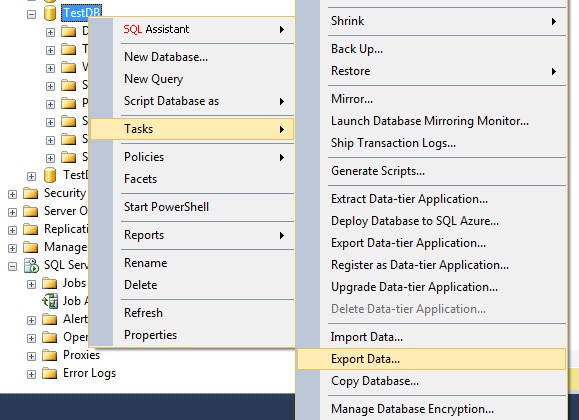
figure-1:任务——导出数据
方法2:
从SQLServer2005开始,可以直接在SSMS上查询出来的结果复制,然后粘贴到Excel上,对于少量数据来说,是非常快速方便的,需要注意的是长数字可能会变成科学记数法的形式,提前在Excel上指定列的格式为文本即可。
导入的话,ctrl + c 复制Excel上的数据,然后在选择相关表,编辑数据,把数据直接粘贴上去即可。但是不建议直接粘贴到业务表(如果表是空白没有数据,并且字段顺序对应,可以这样操作),而是建议先粘贴到一个新建的中间表中,然后再通过语句,把数据插入/更新到业务表。
这种方法的导出导入,适合于少量的数据,如5000行以内的记录,大于5000行以上就不建议了,速度较慢,如果数据过大,还一定成功。
(二)数据库与文本文件、数据库与数据库
数据库之间的数据迁移或导出导入其实是比较方便的,比如备份数据库后,在新的机器上做恢复。但是需要注意的是SQL2008之前的版本的备份无法在SQL2012或以上版本上直接恢复的,而是通过中间的SQL2008做一个过渡,把旧版本的数据库恢复到SQL2008,然后做备份,最后在SQL2012上恢复。
如果是新版本(下面以SQL2012为例)的备份文件恢复到旧版本(以SQL2008为例)上就比较麻烦了,一般是不支持新版本备份文件在旧版本中恢复的。只能通过编写脚本,把新版本的数据导入到旧版本中。
方法1:
首先推荐使用的是数据不落地的“链接服务器”。使用SQL2012的SSMS,同时连接到SQL2012和SQL2008的实例,通过编写脚本把SQL2012的数据导入到SQL2008中。两个实例的可以通过链接服务器来连接。以下是设置步骤。
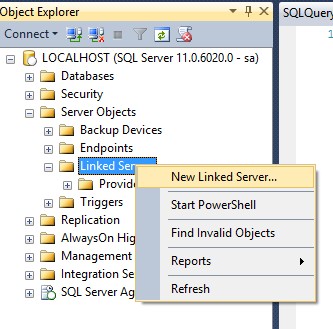
figure-2:新建链接服务器
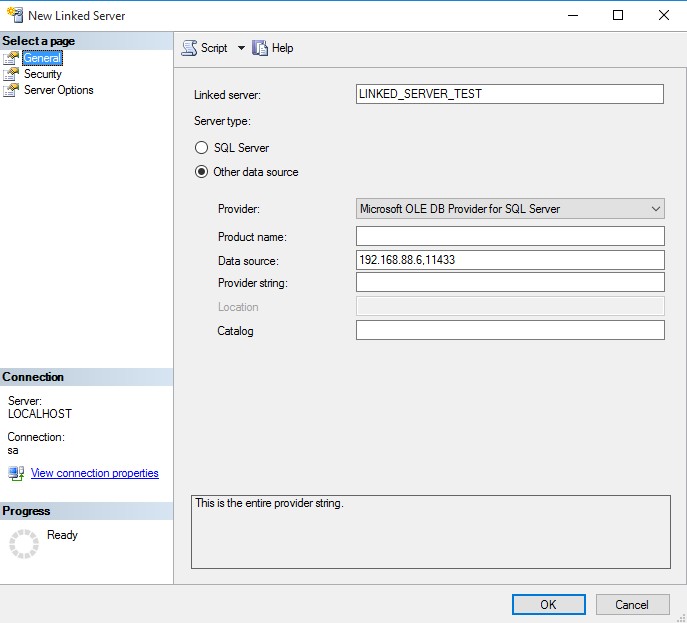
figure-3:链接服务器和数据源
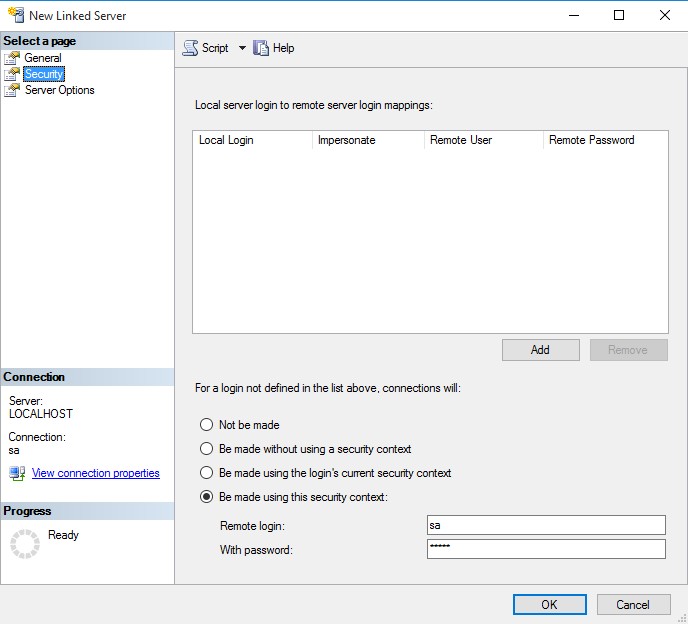
figure-4:认证

figure-5:创建成功后,可以直接浏览链接服务器的目录,也可以使用语句查询了。
也可以使用脚本来创建链接服务器。
--创建链接服务器EXEC sp_addlinkedserver @server='LINKED_SERVER_TEST2',--被访问的服务器别名@srvproduct='',@provider='SQLOLEDB',@datasrc='192.168.88.6,11433'--数据源GO--创建登录名和密码EXEC sys.sp_addlinkedsrvlogin@rmtsrvname = 'LINKED_SERVER_TEST2', -- 被访问的服务器别名@useself = 'false',@locallogin = NULL,@rmtuser = 'sa', -- 数据源登录名@rmtpassword = 'psd123456' -- 数据源登录密码GO--设置数据可以访问EXEC sys.sp_serveroption@server = 'LINKED_SERVER_TEST2', @optname = 'data access',@optvalue = N'true'GO
code-1:创建链接服务器的脚本
创建成功后,可以直接查询数据。
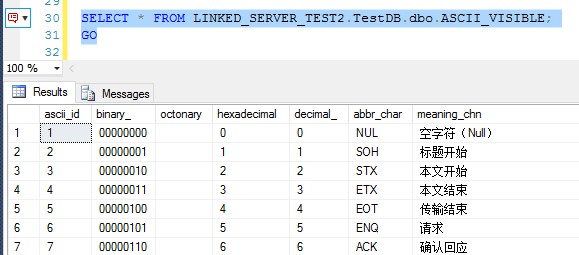
figure-6:查询链接服务器的数据
通过视图sys.servers可以查询所有服务器及相关的属性。
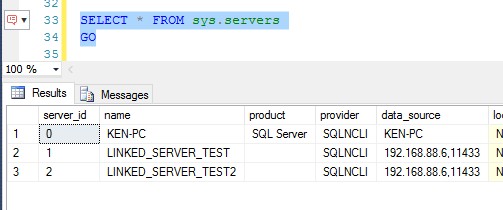
figure-7:查询所有链接服务器
在SSMS上或运行以下脚本可以删除指定的链接服务器。
--删除链接服务器及所有登录EXEC sys.sp_dropserver @server = 'LINKED_SERVER_TEST2', @droplogins = 'droplogins' GO
code-2:删除链接服务器及所有登录
详细请参考:https://technet.microsoft.com/zh-cn/library/ff772782%28v=sql.105%29.aspx
方法2:
如果两个实例不能连接,只能在SQL2012上导出数据,再到SQL2008上导入。SQLServer提供生成包含数据的脚本工具,下图2。在第三步的“高级”选项里有一项“Types of data to scripts”有三个选择:Data only,Schema and data,Schema only,分别是只生成数据、生成表(对象)和数据,表(对象)。还有生成脚本的版本“Script for Server Version”,下图3。其他选项,按实际需要选择。
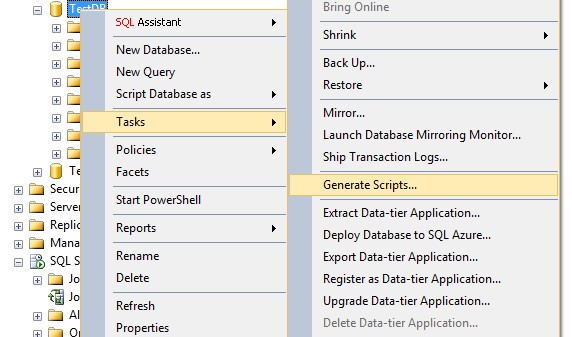
figure-8:任务——生成脚本
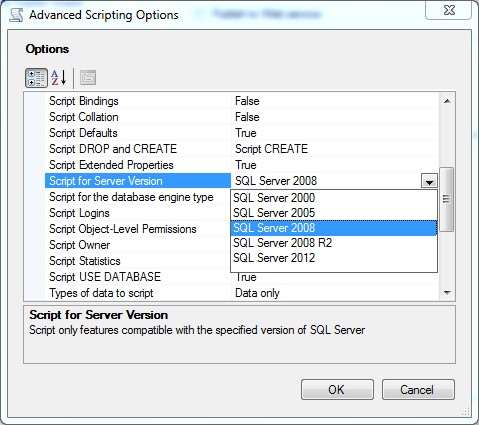
figure-9:生成脚本的高级选项
也可以使用存储过程生成包含数据的脚本。这里介绍一个别人已经做写好存储过程:sp_generate_inserts。运行之后,会按表每条记录生成一条insert的语句
CREATE PROC [dbo].[sp_generate_inserts] ( @table_name VARCHAR(776) , -- The table/view for which the INSERT statements will be generated using the existing data @target_table VARCHAR(776) = NULL , -- Use this parameter to specify a different table name into which the data will be inserted @include_column_list BIT = 1 , -- Use this parameter to include/ommit column list in the generated INSERT statement @from VARCHAR(800) = NULL , -- Use this parameter to filter the rows based on a filter condition (using WHERE) @include_timestamp BIT = 0 , -- Specify 1 for this parameter, if you want to include the TIMESTAMP/ROWVERSION column's data in the INSERT statement @debug_mode BIT = 0 , -- If @debug_mode is set to 1, the SQL statements constructed by this procedure will be printed for later examination @owner VARCHAR(64) = NULL , -- Use this parameter if you are not the owner of the table @ommit_images BIT = 0 , -- Use this parameter to generate INSERT statements by omitting the 'image' columns @ommit_identity BIT = 1 , -- Use this parameter to ommit the identity columns @top INT = NULL , -- Use this parameter to generate INSERT statements only for the TOP n rows @cols_to_include VARCHAR(8000) = NULL , -- List of columns to be included in the INSERT statement @cols_to_exclude VARCHAR(8000) = NULL , -- List of columns to be excluded from the INSERT statement @disable_constraints BIT = 0 , -- When 1, disables foreign key constraints and enables them after the INSERT statements @ommit_computed_cols BIT = 1 -- When 1, computed columns will not be included in the INSERT statement )AS BEGIN/***********************************************************************************************************Procedure: sp_generate_inserts (Build 22) (Copyright ?2002 Narayana Vyas Kondreddi. All rights reserved.) Purpose: To generate INSERT statements from existing data. These INSERTS can be executed to regenerate the data at some other location. This procedure is also useful to create a database setup, where in you can script your data along with your table definitions.Written by: Narayana Vyas Kondreddi http://vyaskn.tripod.comAcknowledgements: Divya Kalra -- For beta testing Mark Charsley -- For reporting a problem with scripting uniqueidentifier columns with NULL values Artur Zeygman -- For helping me simplify a bit of code for handling non-dbo owned tables Joris Laperre -- For reporting a regression bug in handling text/ntext columnsTested on: SQL Server 7.0 and SQL Server 2000Date created: January 17th 2001 21:52 GMTDate modified: May 1st 2002 19:50 GMTEmail: vyaskn@hotmail.comNOTE: This procedure may not work with tables with too many columns. Results can be unpredictable with huge text columns or SQL Server 2000's sql_variant data types Whenever possible, Use @include_column_list parameter to ommit column list in the INSERT statement, for better results IMPORTANT: This procedure is not tested with internation data (Extended characters or Unicode). If needed you might want to convert the datatypes of character variables in this procedure to their respective unicode counterparts like nchar and nvarchar Example 1: To generate INSERT statements for table 'titles': EXEC sp_generate_inserts 'titles'Example 2: To ommit the column list in the INSERT statement: (Column list is included by default) IMPORTANT: If you have too many columns, you are advised to ommit column list, as shown below, to avoid erroneous results EXEC sp_generate_inserts 'titles', @include_column_list = 0Example 3: To generate INSERT statements for 'titlesCopy' table from 'titles' table: EXEC sp_generate_inserts 'titles', 'titlesCopy'Example 4: To generate INSERT statements for 'titles' table for only those titles which contain the word 'Computer' in them: NOTE: Do not complicate the FROM or WHERE clause here. It's assumed that you are good with T-SQL if you are using this parameter EXEC sp_generate_inserts 'titles', @from = "from titles where title like '%Computer%'"Example 5: To specify that you want to include TIMESTAMP column's data as well in the INSERT statement: (By default TIMESTAMP column's data is not scripted) EXEC sp_generate_inserts 'titles', @include_timestamp = 1Example 6: To print the debug information: EXEC sp_generate_inserts 'titles', @debug_mode = 1Example 7: If you are not the owner of the table, use @owner parameter to specify the owner name To use this option, you must have SELECT permissions on that table EXEC sp_generate_inserts Nickstable, @owner = 'Nick'Example 8: To generate INSERT statements for the rest of the columns excluding images When using this otion, DO NOT set @include_column_list parameter to 0. EXEC sp_generate_inserts imgtable, @ommit_images = 1Example 9: To generate INSERT statements excluding (ommiting) IDENTITY columns: (By default IDENTITY columns are included in the INSERT statement) EXEC sp_generate_inserts mytable, @ommit_identity = 1Example 10: To generate INSERT statements for the TOP 10 rows in the table: EXEC sp_generate_inserts mytable, @top = 10Example 11: To generate INSERT statements with only those columns you want: EXEC sp_generate_inserts titles, @cols_to_include = "'title','title_id','au_id'"Example 12: To generate INSERT statements by omitting certain columns: EXEC sp_generate_inserts titles, @cols_to_exclude = "'title','title_id','au_id'"Example 13: To avoid checking the foreign key constraints while loading data with INSERT statements: EXEC sp_generate_inserts titles, @disable_constraints = 1Example 14: To exclude computed columns from the INSERT statement: EXEC sp_generate_inserts MyTable, @ommit_computed_cols = 1***********************************************************************************************************/ SET NOCOUNT ON--Making sure user only uses either @cols_to_include or @cols_to_exclude IF ( ( @cols_to_include IS NOT NULL ) AND ( @cols_to_exclude IS NOT NULL ) ) BEGIN RAISERROR('Use either @cols_to_include or @cols_to_exclude. Do not use both the parameters at once',16,1) RETURN -1 --Failure. Reason: Both @cols_to_include and @cols_to_exclude parameters are specified END--Making sure the @cols_to_include and @cols_to_exclude parameters are receiving values in proper format IF ( ( @cols_to_include IS NOT NULL ) AND ( PATINDEX('''%''', @cols_to_include) = 0 ) ) BEGIN RAISERROR('Invalid use of @cols_to_include property',16,1) PRINT 'Specify column names surrounded by single quotes and separated by commas' PRINT 'Eg: EXEC sp_generate_inserts titles, @cols_to_include = "''title_id'',''title''"' RETURN -1 --Failure. Reason: Invalid use of @cols_to_include property END IF ( ( @cols_to_exclude IS NOT NULL ) AND ( PATINDEX('''%''', @cols_to_exclude) = 0 ) ) BEGIN RAISERROR('Invalid use of @cols_to_exclude property',16,1) PRINT 'Specify column names surrounded by single quotes and separated by commas' PRINT 'Eg: EXEC sp_generate_inserts titles, @cols_to_exclude = "''title_id'',''title''"' RETURN -1 --Failure. Reason: Invalid use of @cols_to_exclude property END--Checking to see if the database name is specified along wih the table name--Your database context should be local to the table for which you want to generate INSERT statements--specifying the database name is not allowed IF ( PARSENAME(@table_name, 3) ) IS NOT NULL BEGIN RAISERROR('Do not specify the database name. Be in the required database and just specify the table name.',16,1) RETURN -1 --Failure. Reason: Database name is specified along with the table name, which is not allowed END--Checking for the existence of 'user table' or 'view'--This procedure is not written to work on system tables--To script the data in system tables, just create a view on the system tables and script the view instead IF @owner IS NULL BEGIN IF ( ( OBJECT_ID(@table_name, 'U') IS NULL ) AND ( OBJECT_ID(@table_name, 'V') IS NULL ) ) BEGIN RAISERROR('User table or view not found.',16,1) PRINT 'You may see this error, if you are not the owner of this table or view. In that case use @owner parameter to specify the owner name.' PRINT 'Make sure you have SELECT permission on that table or view.' RETURN -1 --Failure. Reason: There is no user table or view with this name END END ELSE BEGIN IF NOT EXISTS ( SELECT 1 FROM INFORMATION_SCHEMA.TABLES WHERE TABLE_NAME = @table_name AND ( TABLE_TYPE = 'BASE TABLE' OR TABLE_TYPE = 'VIEW' ) AND TABLE_SCHEMA = @owner ) BEGIN RAISERROR('User table or view not found.',16,1) PRINT 'You may see this error, if you are not the owner of this table. In that case use @owner parameter to specify the owner name.' PRINT 'Make sure you have SELECT permission on that table or view.' RETURN -1 --Failure. Reason: There is no user table or view with this name END END--Variable declarations DECLARE @Column_ID INT , @Column_List NVARCHAR(MAX) , @Column_Name VARCHAR(128) , @Start_Insert NVARCHAR(MAX) , @Data_Type VARCHAR(128) , @Actual_Values NVARCHAR(MAX) , --This is the string that will be finally executed to generate INSERT statements @IDN VARCHAR(128) --Will contain the IDENTITY column's name in the table--Variable Initialization SET @IDN = '' SET @Column_ID = 0 SET @Column_Name = '' SET @Column_List = '' SET @Actual_Values = '' IF @owner IS NULL BEGIN SET @Start_Insert = 'INSERT INTO ' + '[' + RTRIM(COALESCE(@target_table, @table_name)) + ']' END ELSE BEGIN SET @Start_Insert = 'INSERT ' + '[' + LTRIM(RTRIM(@owner)) + '].' + '[' + RTRIM(COALESCE(@target_table, @table_name)) + ']' END--To get the first column's ID SELECT @Column_ID = MIN(ORDINAL_POSITION) FROM INFORMATION_SCHEMA.COLUMNS (NOLOCK) WHERE TABLE_NAME = @table_name AND ( @owner IS NULL OR TABLE_SCHEMA = @owner )--Loop through all the columns of the table, to get the column names and their data types WHILE @Column_ID IS NOT NULL BEGIN SELECT @Column_Name = QUOTENAME(COLUMN_NAME) , @Data_Type = DATA_TYPE FROM INFORMATION_SCHEMA.COLUMNS (NOLOCK) WHERE ORDINAL_POSITION = @Column_ID AND TABLE_NAME = @table_name AND ( @owner IS NULL OR TABLE_SCHEMA = @owner ) IF @cols_to_include IS NOT NULL --Selecting only user specified columns BEGIN IF CHARINDEX('''' + SUBSTRING(@Column_Name, 2, LEN(@Column_Name) - 2) + '''', @cols_to_include) = 0 BEGIN GOTO SKIP_LOOP END END IF @cols_to_exclude IS NOT NULL --Selecting only user specified columns BEGIN IF CHARINDEX('''' + SUBSTRING(@Column_Name, 2, LEN(@Column_Name) - 2) + '''', @cols_to_exclude) <> 0 BEGIN GOTO SKIP_LOOP END END --Making sure to output SET IDENTITY_INSERT ON/OFF in case the table has an IDENTITY column IF ( SELECT COLUMNPROPERTY(OBJECT_ID(QUOTENAME(COALESCE(@owner, USER_NAME())) + '.' + @table_name), SUBSTRING(@Column_Name, 2, LEN(@Column_Name) - 2), 'IsIdentity') ) = 1 BEGIN IF @ommit_identity = 0 --Determing whether to include or exclude the IDENTITY column SET @IDN = @Column_Name ELSE GOTO SKIP_LOOP END --Making sure whether to output computed columns or not IF @ommit_computed_cols = 1 BEGIN IF ( SELECT COLUMNPROPERTY(OBJECT_ID(QUOTENAME(COALESCE(@owner, USER_NAME())) + '.' + @table_name), SUBSTRING(@Column_Name, 2, LEN(@Column_Name) - 2), 'IsComputed') ) = 1 BEGIN GOTO SKIP_LOOP END END --Tables with columns of IMAGE data type are not supported for obvious reasons IF ( @Data_Type IN ( 'image' ) ) BEGIN IF ( @ommit_images = 0 ) BEGIN RAISERROR('Tables with image columns are not supported.',16,1) PRINT 'Use @ommit_images = 1 parameter to generate INSERTs for the rest of the columns.' PRINT 'DO NOT ommit Column List in the INSERT statements. If you ommit column list using @include_column_list=0, the generated INSERTs will fail.' RETURN -1 --Failure. Reason: There is a column with image data type END ELSE BEGIN GOTO SKIP_LOOP END END --Determining the data type of the column and depending on the data type, the VALUES part of --the INSERT statement is generated. Care is taken to handle columns with NULL values. Also --making sure, not to lose any data from flot, real, money, smallmomey, datetime columns SET @Actual_Values = @Actual_Values + CASE WHEN @Data_Type IN ( 'char', 'varchar', 'nchar','nvarchar' ) THEN 'COALESCE(''N'''''' + REPLACE(RTRIM(' + @Column_Name + '),'''''''','''''''''''')+'''''''',''NULL'')' WHEN @Data_Type IN ( 'datetime', 'smalldatetime', 'DATE','time' ) THEN 'COALESCE('''''''' + RTRIM(CONVERT(char,' + @Column_Name + ',120))+'''''''',''NULL'')' WHEN @Data_Type IN ( 'uniqueidentifier' ) THEN 'COALESCE('''''''' + REPLACE(CONVERT(char(255),RTRIM(' + @Column_Name + ')),'''''''','''''''''''')+'''''''',''NULL'')' WHEN @Data_Type IN ( 'text', 'ntext' ) THEN 'COALESCE(''N'''''' + REPLACE(CONVERT(char(8000),' + @Column_Name + '),'''''''','''''''''''')+'''''''',''NULL'')' WHEN @Data_Type IN ( 'binary', 'varbinary' ) THEN 'COALESCE(RTRIM(CONVERT(char,' + 'CONVERT(int,' + @Column_Name + '))),''NULL'')' WHEN @Data_Type IN ( 'timestamp', 'rowversion' ) THEN CASE WHEN @include_timestamp = 0 THEN '''DEFAULT''' ELSE 'COALESCE(RTRIM(CONVERT(char,' + 'CONVERT(int,' + @Column_Name + '))),''NULL'')' END WHEN @Data_Type IN ( 'hierarchyid' ) THEN 'COALESCE(''CAST(''''''+LTRIM(RTRIM(' + 'CONVERT(char, ' + @Column_Name + ')' + ')),''NULL'')' + '+''''''AS hierarchyid)''' WHEN @Data_Type IN ( 'float', 'real', 'money', 'smallmoney' ) THEN 'COALESCE(LTRIM(RTRIM(' + 'CONVERT(char, ' + @Column_Name + ',2)' + ')),''NULL'')' ELSE 'COALESCE(LTRIM(RTRIM(' + 'CONVERT(char, ' + @Column_Name + ')' + ')),''NULL'')' END + '+' + ''',''' + ' + ' --Generating the column list for the INSERT statement SET @Column_List = @Column_List + @Column_Name + ',' SKIP_LOOP: --The label used in GOTO SELECT @Column_ID = MIN(ORDINAL_POSITION) FROM INFORMATION_SCHEMA.COLUMNS (NOLOCK) WHERE TABLE_NAME = @table_name AND ORDINAL_POSITION > @Column_ID AND ( @owner IS NULL OR TABLE_SCHEMA = @owner ) --Loop ends here! END--To get rid of the extra characters that got concatenated during the last run through the loop SET @Column_List = LEFT(@Column_List, LEN(@Column_List) - 1) SET @Actual_Values = LEFT(@Actual_Values, LEN(@Actual_Values) - 6) IF LTRIM(@Column_List) = '' BEGIN RAISERROR('No columns to select. There should at least be one column to generate the output',16,1) RETURN -1 --Failure. Reason: Looks like all the columns are ommitted using the @cols_to_exclude parameter END--Forming the final string that will be executed, to output the INSERT statements IF ( @include_column_list <> 0 ) BEGIN SET @Actual_Values = 'SELECT ' + CASE WHEN @top IS NULL OR @top < 0 THEN '' ELSE ' TOP ' + LTRIM(STR(@top)) + ' ' END + '''' + RTRIM(@Start_Insert) + ' ''+' + '''(' + RTRIM(@Column_List) + '''+' + ''')''' + ' +''VALUES(''+ ' + @Actual_Values + '+'')''' + ' ' + COALESCE(@from, ' FROM ' + CASE WHEN @owner IS NULL THEN '' ELSE '[' + LTRIM(RTRIM(@owner)) + '].' END + '[' + RTRIM(@table_name) + ']' + '(NOLOCK)') END ELSE IF ( @include_column_list = 0 ) BEGIN SET @Actual_Values = 'SELECT ' + CASE WHEN @top IS NULL OR @top < 0 THEN '' ELSE ' TOP ' + LTRIM(STR(@top)) + ' ' END + '''' + RTRIM(@Start_Insert) + ' '' +''VALUES(''+ ' + @Actual_Values + '+'')''' + ' ' + COALESCE(@from, ' FROM ' + CASE WHEN @owner IS NULL THEN '' ELSE '[' + LTRIM(RTRIM(@owner)) + '].' END + '[' + RTRIM(@table_name) + ']' + '(NOLOCK)') END --Determining whether to ouput any debug information IF @debug_mode = 1 BEGIN PRINT '/*****START OF DEBUG INFORMATION*****' PRINT 'Beginning of the INSERT statement:' PRINT @Start_Insert PRINT '' PRINT 'The column list:' --PRINT @Column_List PRINT '' PRINT 'The SELECT statement executed to generate the INSERTs' PRINT @Actual_Values PRINT '' PRINT '*****END OF DEBUG INFORMATION*****/' PRINT '' END --PRINT '--INSERTs generated by ''sp_generate_inserts'' stored procedure written by Vyas' --PRINT '--Build number: 22' --PRINT '--Problems/Suggestions? Contact Vyas @ vyaskn@hotmail.com' --PRINT '--http://vyaskn.tripod.com' --PRINT '' --PRINT 'SET NOCOUNT ON' --PRINT ''--Determining whether to print IDENTITY_INSERT or not IF ( @IDN <> '' ) BEGIN PRINT 'SET IDENTITY_INSERT ' + QUOTENAME(COALESCE(@owner, USER_NAME())) + '.' + QUOTENAME(@table_name) + ' ON' PRINT 'GO' PRINT '' END IF @disable_constraints = 1 AND ( OBJECT_ID(QUOTENAME(COALESCE(@owner, USER_NAME())) + '.' + @table_name, 'U') IS NOT NULL ) BEGIN IF @owner IS NULL BEGIN SELECT 'ALTER TABLE ' + QUOTENAME(COALESCE(@target_table, @table_name)) + ' NOCHECK CONSTRAINT ALL' AS '--Code to disable constraints temporarily' END ELSE BEGIN SELECT 'ALTER TABLE ' + QUOTENAME(@owner) + '.' + QUOTENAME(COALESCE(@target_table, @table_name)) + ' NOCHECK CONSTRAINT ALL' AS '--Code to disable constraints temporarily' END PRINT 'GO' END PRINT '' PRINT 'PRINT ''Inserting values into ' + '[' + RTRIM(COALESCE(@target_table, @table_name)) + ']' + ''''--All the hard work pays off here!!! You'll get your INSERT statements, when the next line executes! EXEC (@Actual_Values) PRINT 'PRINT ''Done''' PRINT '' IF @disable_constraints = 1 AND ( OBJECT_ID(QUOTENAME(COALESCE(@owner, USER_NAME())) + '.' + @table_name, 'U') IS NOT NULL ) BEGIN IF @owner IS NULL BEGIN SELECT 'ALTER TABLE ' + QUOTENAME(COALESCE(@target_table, @table_name)) + ' CHECK CONSTRAINT ALL' AS '--Code to enable the previously disabled constraints' END ELSE BEGIN SELECT 'ALTER TABLE ' + QUOTENAME(@owner) + '.' + QUOTENAME(COALESCE(@target_table, @table_name)) + ' CHECK CONSTRAINT ALL' AS '--Code to enable the previously disabled constraints' END PRINT 'GO' END PRINT '' IF ( @IDN <> '' ) BEGIN PRINT 'SET IDENTITY_INSERT ' + QUOTENAME(COALESCE(@owner, USER_NAME())) + '.' + QUOTENAME(@table_name) + ' OFF' PRINT 'GO' END --PRINT 'SET NOCOUNT OFF' SET NOCOUNT OFF RETURN 0 --Success. We are done! ENDGOcode-3:sp_generate_inserts脚本源代码
在我的实际使用中,只有两三个参数比较常用,分别是@table_name、@from和@owner,如果表的架构使用默认的dbo,则可以省略。以下是一个使用的例子:
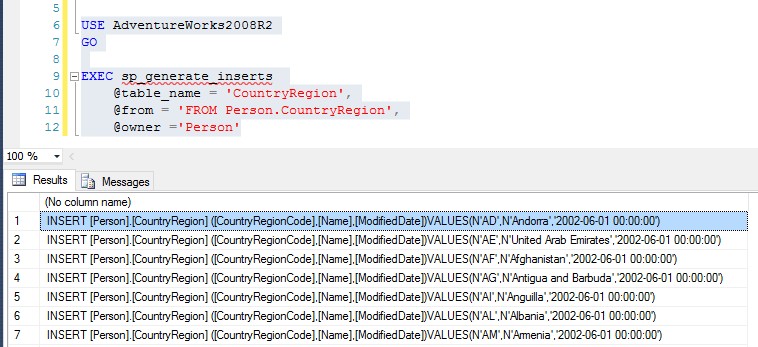
figure-10:使用sp_generate_inserts的一个例子
其他参数的用法,这里就不一一解释了。我经常使用这个存储过程做一些简单而少量(如数万行记录以内)的数据导出导入,比前面介绍的方法方便快捷许多。但这个存储过程支持处理一般常用的数据类型,像XML这种类型则不支持。还有,如果生成的数据太多太大,SSMS返回数据会很慢,甚至SSMS会挂了,这时还是使用SSMS自带的导出脚本到文件稳妥些。如果使用生成的数据脚本文件很大,几百MB甚至上GB,在导入时,就不能直接使用SSMS直接打开来执行了。可以使用SQLCMD实用工具来在执行脚本。如下面的一个例子,在D盘下有一个脚本1.sql,内容为:
USE AdventureWorks2008R2GOSELECT * FROM Person.CountryRegion;GO
code-4:SQLMCD的测试脚本
在运行下输入CMD,输入:
sqlcmd -S localhost -d AdventureWorks2008R2 -i D:\1.sql
code-5:SQLMCD的命令
回车执行后如下图,SQLCMD的详细用法,请参考:https://msdn.microsoft.com/zh-cn/library/ms180944.aspx 和 https://msdn.microsoft.com/zh-cn/library/ms162773%28v=sql.105%29.aspx

figure-11:SQLCMD的测试例子
方法3:
使用BCP导出导入大容量数据。可以参阅我的另一篇博客《BCP导出导入大容量数据实践》。
以上几种方法是我在日常工作比较常使用的数据导出导入的工具,每一种方法都有各自的优势和不同的使用场景,使用不同的方法组合,可以节省不少时间,提高工作效率,希望对您的有所帮助。如果您有更好的建议或方法欢迎告诉我!
- SQL SERVER几种数据迁移/导出导入的实践
- mysql的几种数据导入导出总结
- Hive几种数据导入导出方式
- SQL Server数据导入导出的几种方法
- SQL Server数据导入导出的几种方法
- Hive的几种数据导入方式
- sql server 导入导出!!
- SQL Server导入导出
- Sql Server 导入导出
- 导入导出sql server
- SQL server中数据库中几种数据类型的区别
- SQL SERVER使用OpenRowset,、OpenDataSource函数导入、导出数据到Excel 的几种方法(整理)
- SQL SERVER使用OpenRowset,、OpenDataSource函数导入、导出数据到Excel 的几种方法(整理)
- SQL Server中数据的导入导出
- sql server 数据的导入导出命令
- sql server 的 bcp 导入导出
- sql server的导入导出工具
- sql server的BCP导入导出
- Django的中间件
- 音频混音的算法实现
- 内核模块化编程的细节
- 34.Button控件(按钮,用于程序和用户的交互)
- Spring 上传文件
- SQL SERVER几种数据迁移/导出导入的实践
- angular4 项目启动报错
- mybatis教程
- Select服务器
- 由浅入深JavaScript6基础-语句1
- 王垠:自动编程是不可能的 我为什么不在乎人工智能
- 应用机器学习(九):主成分分析
- sql语句多条件查询
- java基本类型和引用类型


